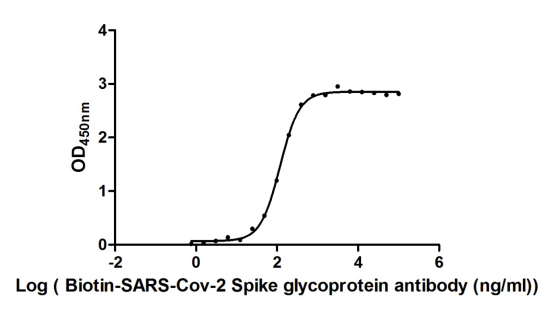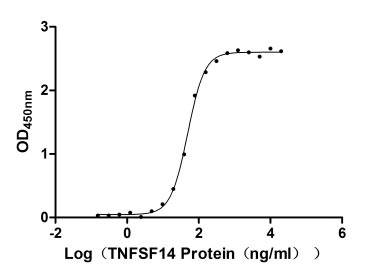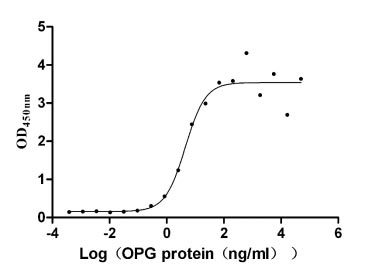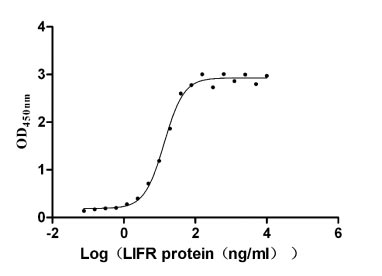Recombinant Human Pituitary tumor-transforming gene 1 protein-interacting protein (PTTG1IP), partial
-
中文名称:人PTTG1IP重组蛋白
-
货号:CSB-YP019075HU1
-
规格:
-
来源:Yeast
-
其他:
-
中文名称:人PTTG1IP重组蛋白
-
货号:CSB-EP019075HU1
-
规格:
-
来源:E.coli
-
其他:
-
中文名称:人PTTG1IP重组蛋白
-
货号:CSB-EP019075HU1-B
-
规格:
-
来源:E.coli
-
共轭:Avi-tag Biotinylated
E. coli biotin ligase (BirA) is highly specific in covalently attaching biotin to the 15 amino acid AviTag peptide. This recombinant protein was biotinylated in vivo by AviTag-BirA technology, which method is BriA catalyzes amide linkage between the biotin and the specific lysine of the AviTag.
-
其他:
-
中文名称:人PTTG1IP重组蛋白
-
货号:CSB-BP019075HU1
-
规格:
-
来源:Baculovirus
-
其他:
-
中文名称:人PTTG1IP重组蛋白
-
货号:CSB-MP019075HU1
-
规格:
-
来源:Mammalian cell
-
其他:
产品详情
-
纯度:>85% (SDS-PAGE)
-
基因名:PTTG1IP
-
Uniprot No.:
-
别名:PTTG1IP; C21orf1; C21orf3; Pituitary tumor-transforming gene 1 protein-interacting protein; Pituitary tumor-transforming gene protein-binding factor; PBF; PTTG-binding factor
-
种属:Homo sapiens (Human)
-
蛋白长度:Partial
-
蛋白标签:Tag type will be determined during the manufacturing process.
The tag type will be determined during production process. If you have specified tag type, please tell us and we will develop the specified tag preferentially. -
产品提供形式:Lyophilized powder
Note: We will preferentially ship the format that we have in stock, however, if you have any special requirement for the format, please remark your requirement when placing the order, we will prepare according to your demand. -
复溶:We recommend that this vial be briefly centrifuged prior to opening to bring the contents to the bottom. Please reconstitute protein in deionized sterile water to a concentration of 0.1-1.0 mg/mL.We recommend to add 5-50% of glycerol (final concentration) and aliquot for long-term storage at -20℃/-80℃. Our default final concentration of glycerol is 50%. Customers could use it as reference.
-
储存条件:Store at -20°C/-80°C upon receipt, aliquoting is necessary for mutiple use. Avoid repeated freeze-thaw cycles.
-
保质期:The shelf life is related to many factors, storage state, buffer ingredients, storage temperature and the stability of the protein itself.
Generally, the shelf life of liquid form is 6 months at -20°C/-80°C. The shelf life of lyophilized form is 12 months at -20°C/-80°C. -
货期:Delivery time may differ from different purchasing way or location, please kindly consult your local distributors for specific delivery time.Note: All of our proteins are default shipped with normal blue ice packs, if you request to ship with dry ice, please communicate with us in advance and extra fees will be charged.
-
注意事项:Repeated freezing and thawing is not recommended. Store working aliquots at 4°C for up to one week.
-
Datasheet :Please contact us to get it.
相关产品
靶点详情
-
功能:May facilitate PTTG1 nuclear translocation.
-
基因功能参考文献:
- Nnegative pituitary tumor-transforming gene 1 protein-interacting protein (PTTG1IP) immunoexpression predicted a 1.5-fold risk of breast cancer death. PMID: 29078751
- data reveal new insight into PBF function and confirm that, rather than being oncogenic, mutations in PBF are likely to be passenger effects, with overexpression of PBF the more important etiological event in human cancer PMID: 28676500
- PTTG1IP and MAML3 are associated with BHR severity in adult asthma. The relevance of these genes is supported by the eQTL analyses and co-expression of PTTG1lP with vimentin and E-cadherin1, and MAML3 with MAML2. PMID: 27709636
- Findings indicate that PBF and PTTG have a critical role in promoting thyroid cancer that is predictive of poorer patient outcome. PMID: 28504713
- Unique role for PBF in regulating CTTN function to promote endocrine cell invasion and migration. PMID: 27603901
- these results demonstrate an emerging role for PBF in colorectal tumorigenesis through regulating p53 activity, with implications for PBF as a prognostic indicator for invasive tumors. PMID: 25408419
- These findings indicate that miR-584 suppresses glioma cell growth by negatively regulating the expression of PTTG1IP, suggesting that miR-584 has a tumor suppressive role in human glioma pathogenesis. PMID: 25674221
- protooncogene PBF is a negative regulator of p53 function in thyroid tumorigenesis, in which PBF is generally overexpressed and p53 mutations are rare compared with other tumor types PMID: 24506068
- Data from mutant recombinant proteins suggest that proto-oncogene PBF is a phosphoprotein and highlight importance of tyrosine residue Y174 in both endocytosis of PBF and its interaction/co-localization with NIS/SLC5A5 (sodium-iodide symporter). PMID: 23678037
- PBF expression may be a promising biomarker for prognostic and therapeutic purposes in papillary thyroid carcinoma patients. PMID: 22888961
- s identified pituitary tumor-transforming gene 1 (PTTG1) binding factor (PBF) as a target of miR-122 and demonstrated that hepatitis B virus replication causes an obvious increase in PBF levels. PMID: 23221562
- The present study provides the first epidemiological evidence that functional regulatory variants of PTTG1IP were associated with the risk of ER-positive breast cancer, further supporting its relevance as one proto-oncogene in breast cancer. PMID: 22404099
- overexpression of PBF causes thyroid cell proliferation, macrofollicular lesions, and hyperplasia, as well as repression of the critical therapeutic route for radioiodide uptake PMID: 21844185
- PBF's role in endocrine cancer is discussed. [review] PMID: 21129230
- PTTG expression was higher in malignant cells than in primary astrocytes, whereas PTTG-binding factor was not in astrocytoma PMID: 15178645
- overexpression of PTTG and PBF in differentiated thyroid cancer has profound implications for activity of the NIS gene, and hence significantly impacts upon the efficacy of radioiodine treatment. PMID: 17297475
显示更多
收起更多
-
亚细胞定位:Membrane; Single-pass type I membrane protein. Cytoplasm. Nucleus. Note=According to PubMed:10781616, it is found in the cytoplasm and the nucleus.
-
组织特异性:Ubiquitous.
-
数据库链接:
HGNC: 13524
OMIM: 603784
KEGG: hsa:754
STRING: 9606.ENSP00000328325
UniGene: Hs.474010
Most popular with customers
-
Recombinant Severe acute respiratory syndrome coronavirus 2 Spike glycoprotein (S), partial (Active)
Express system: Mammalian cell
Species: Severe acute respiratory syndrome coronavirus 2 (2019-nCoV) (SARS-CoV-2)
-
Recombinant Human Tumor necrosis factor ligand superfamily member 14 (TNFSF14), partial (Active)
Express system: Mammalian cell
Species: Homo sapiens (Human)
-
Recombinant Human Tumor necrosis factor receptor superfamily member 11B (TNFRSF11B) (Active)
Express system: Mammalian cell
Species: Homo sapiens (Human)
-
Recombinant Human Leukemia inhibitory factor receptor (LIFR), partial (Active)
Express system: Mammalian cell
Species: Homo sapiens (Human)
-
Recombinant Human Interleukin-17A (IL17A) (T26A) (Active)
Express system: Baculovirus
Species: Homo sapiens (Human)
-
Recombinant Human Alkaline phosphatase, germ cell type (ALPG) (Active)
Express system: Mammalian cell
Species: Homo sapiens (Human)
-
Recombinant Human Interleukin-2 (IL2) (Active)
Express system: Mammalian cell
Species: Homo sapiens (Human)
-
Recombinant Human C-C chemokine receptor type 6(CCR6)-VLPs (Active)
Express system: Mammalian cell
Species: Homo sapiens (Human)






-AC1.jpg)













